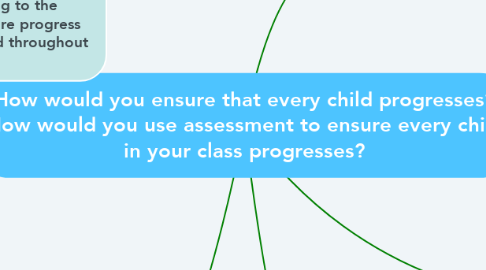
1. Due to the large scale of abilities and needs, a thorough and adaptable bank of knowledge surrounding the EYFS will be something I will continue to develop throughout my teaching career to ensure I am ready to give whatever is needed to ensure every child I teach progresses.
1.1. includes subject knowledge, pedagogy, and learning styles.
1.1.1. important as the EYFS explicitly states that children develop at their own rates, and in their own ways, and therefore as my role as facilitator of learning, I have an accountability to be aware of these within my class, and then use my own professional judgement of the child to act upon them to ensure all children progress, not just the ones with a preferred learning style or level of access to the curriculum.
1.1.1.1. Through this adaptability and thorough knowledge, I am then able to differentiate activities and learning for all children to access.
2. However, I am aware that it is not just planned learning which creates progress, but by also allowing the use of play as a way to help children develop a broad range of knowledge and skills, that according to the EYFS will help future progress through school and throughout life.
2.1. Despite the importance of this being outlined in policy such as the EYFS, as Santer et al 2007 states, there is no concise or agreed definition of play, and so due to my time at placement am aware of the concerns that may arise from this as children may not have experiences to relate to within their own play.
2.2. I feel however, as backed up by Whitebread 2012, it is about creating a trust in which the children learn independently by using their own social experiences, allowing them to follow their own ideas and thoughts, in an environment where the children also trust you and other members of the classroom.
3. BUT.. may have created further gaps within progress in the class if I hadn’t have remained mindful that some children were not having the same learning opportunities or experiences within their own home setting, and in some cases Tapestry may instead create a communication barrier between practitioners, other practitioners, and parents, as it can stop discussions about the child and their next steps.
3.1. Therefore found it important to always discuss the observations with the children, giving them verbal feedback and next steps in their learning, and then ensure other practitioners knew these next steps to then also facilitate opportunities to reflect these within provision.
3.1.1. Parental Engagement workshops in future would:
4. Certainly, assessment plays a role in ensuring every child in my class progresses, and through my time at placement I understand how effective formatively assessing children through observations can be at ensuring progress within each child.
4.1. Most recently used Tapestry at last placement. Online observation tool.
4.1.1. provided a valuable insight into individual children’s achievements, interests, and progress. I was able to observe children as they acted and interacted in their play, everyday activities, and planned activities,
4.1.2. Parental Feature: allowed me to view observations that had been taken in the home setting by parents, and vice versa.
4.1.2.1. Palaiologou 2013, sharing observations between home and early years’ settings offers great opportunities for the child as it identifies the progress they are making in both settings, which can then be acted upon within school by creating plans for further supporting and promoting learning and development.
5. Regardless of this, observations showed pupils prior knowledge which is important to ensure children progress.
5.1. Could see learning prior to placement
5.1.1. Assessed against the EYFS so could see gaps and areas of development
5.1.2. Revisit any areas both individually as in intervention or as a whole class revisit, before moving onto a different area of the curriculum, assess them again, and then plan for next steps.
5.2. tailor provision and differentiate activities to suit their needs, showing how I used these observations to plan for next steps of progress, or revisit a topic if the observations showed a misconception.
5.2.1. Links to EYFS as it states observation creates a basis of a cycle of formative assessment and curriculum planning.
5.2.2. Cycle continued as a constant process to stimulate and support learning within my class during placement, which in turn helped me to develop teaching standard 5 due to the large scale of abilities and needs within my class which can be shown in these pieces of work. SHOW EXAMPLES
